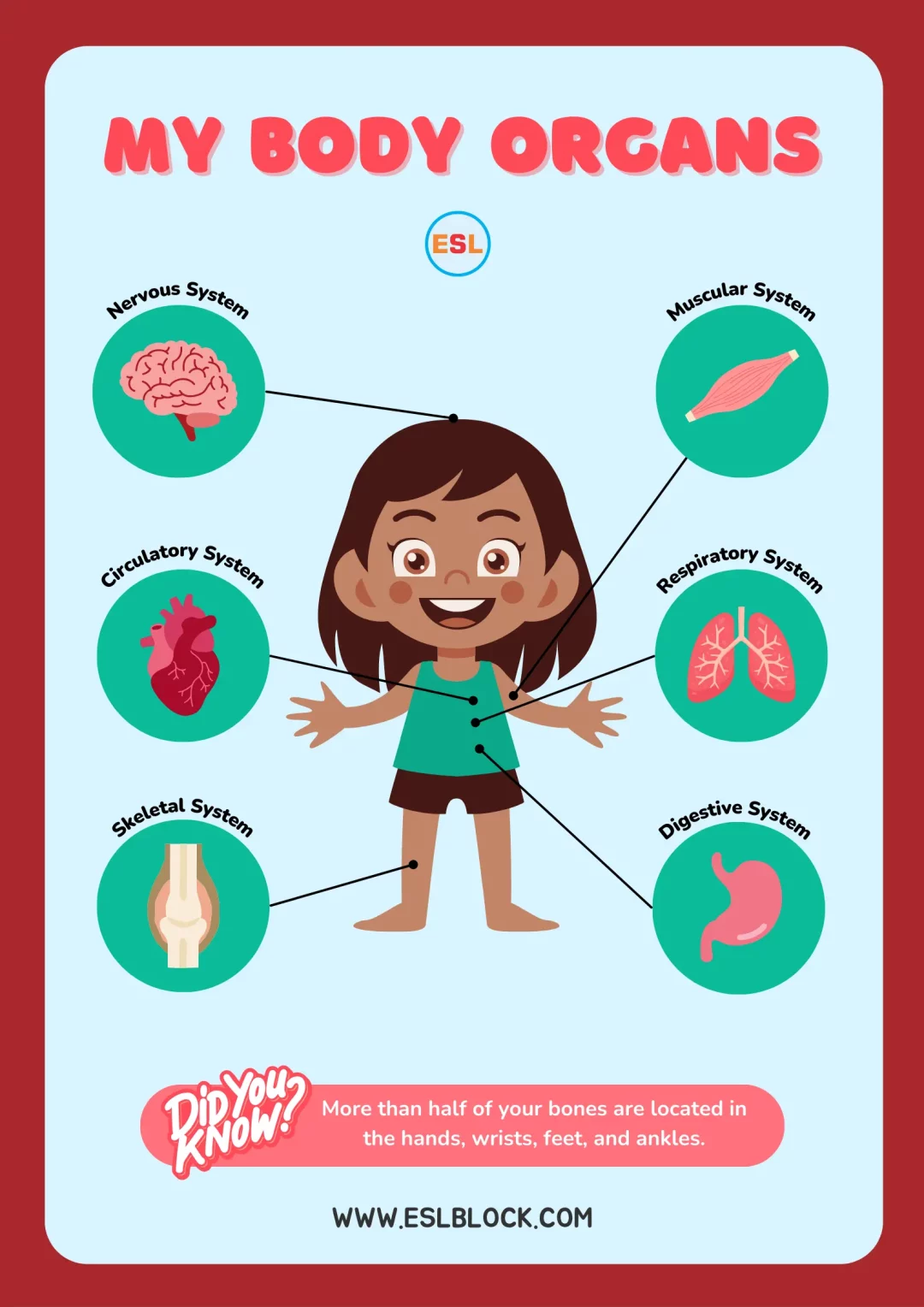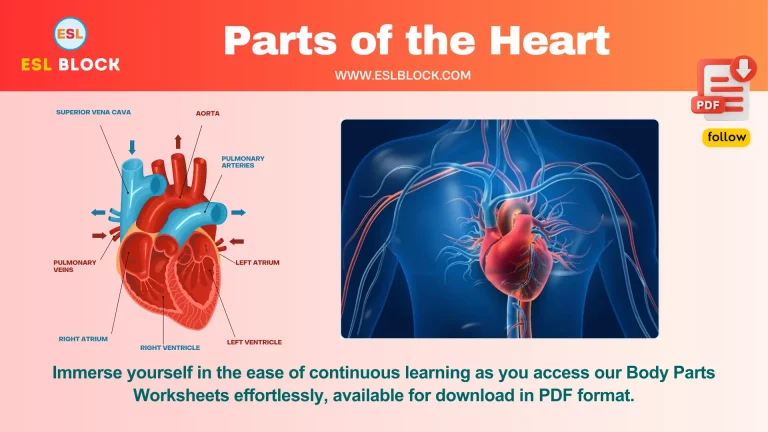Human Body Organs: Internal Body Parts Vocabulary

Understanding the internal organs of the human body and their functions is crucial for grasping how our bodies work. This comprehensive guide will explore the vocabulary related to human body organs, providing detailed explanations of each internal body part.
Whether you’re a student, healthcare professional, or simply interested in anatomy, this article will equip you with the essential knowledge to better understand the complex systems that keep us alive and healthy.
“Verified for accuracy, body organs vocabulary listed here have been sourced from reputable references. Source: Your Info Master.”
- Human Body Organs
- Heart
- Lungs
- Brain
- Liver
- Kidneys
- Stomach
- Small Intestine
- Large Intestine (Colon)
- Pancreas
- Gallbladder
- Spleen
- Bladder
- Esophagus
- Trachea
- Thyroid Gland
- Parathyroid Glands
- Adrenal Glands
- Pituitary Gland
- Hypothalamus
- Pineal Gland
- Thymus
- Appendix
- Skin
- Eyes
- Ears
- Nose
- Mouth
- Pharynx
- Larynx
- Ovaries
- Testes
- Uterus
- Fallopian Tubes
- Prostate Gland
- Seminal Vesicles
- Vas Deferens
- Scrotum
- Epididymis
- Clitoris
- Labia Majora
- Labia Minora
- Vagina
- Cervix
- Rectum
- Anus
- Diaphragm
- Mesentery
- Peritoneum
- Ureters
- Urethra
- Arteries
- Veins
- Capillaries
- Lymph Nodes
- Lymphatic Vessels
- Bone Marrow
- Bones
- Joints
- Cartilage
- Tendons
- Ligaments
- Muscles
- Intercostal Muscles
- Salivary Glands
- Tonsils
- Adenoids
- Hair Follicles
- Nails
- Sweat Glands
- Sebaceous Glands
- Olfactory Bulb
- Cochlea
- Retina
- Iris
- Conclusion
- Related Articles
Read also: Parts of the Face with Pictures






Human Body Organs
Heart
The heart is a muscular organ responsible for pumping blood throughout the body. It maintains the circulation of oxygen-rich blood and nutrients to tissues and organs.
Lungs
The lungs are two spongy organs that facilitate gas exchange, allowing oxygen to enter the bloodstream and carbon dioxide to be expelled from the body.
Brain
The brain is the central control unit of the nervous system, responsible for processing sensory information, regulating bodily functions, and enabling thought and consciousness.
Liver
The liver is a large, vital organ that processes nutrients, detoxifies harmful substances, and produces bile to aid digestion.
Kidneys
The kidneys filter waste products and excess fluids from the blood to form urine, maintaining electrolyte balance and blood pressure.
Stomach
The stomach is a muscular organ that breaks down food using gastric acids and enzymes, initiating the digestive process.
Small Intestine
The small intestine is a long, coiled tube where most of the digestion and absorption of nutrients occurs.
Large Intestine (Colon)
The large intestine absorbs water and electrolytes from indigestible food matter and compacts waste into feces for excretion.
Pancreas
The pancreas produces enzymes that aid in digestion and hormones like insulin that regulate blood sugar levels.
Gallbladder
The gallbladder stores bile produced by the liver and releases it into the small intestine to help digest fats.
Spleen
The spleen filters blood, recycles old red blood cells, and helps fight infections by producing white blood cells.
Bladder
The bladder stores urine produced by the kidneys until it is expelled from the body during urination.
Esophagus
The esophagus is a muscular tube that transports food and liquids from the throat to the stomach.
Trachea
The trachea, or windpipe, is a tube that carries air from the larynx to the bronchi and lungs.
Thyroid Gland
The thyroid gland produces hormones that regulate metabolism, growth, and development.
Parathyroid Glands
The parathyroid glands produce hormones that regulate calcium levels in the blood and bone metabolism.
Adrenal Glands
The adrenal glands produce hormones like adrenaline and cortisol that help regulate metabolism, immune response, and stress.
Pituitary Gland
The pituitary gland, often called the “master gland,” controls various other glands and regulates growth, metabolism, and reproductive functions.
Hypothalamus
The hypothalamus is a small brain region that regulates bodily functions such as temperature, hunger, thirst, and hormone release.
Pineal Gland
The pineal gland produces melatonin, which regulates sleep-wake cycles.
Thymus
The thymus is involved in developing and maturing T-cells, which are critical for the immune response.
Appendix
The appendix is a small, tube-like structure attached to the large intestine, thought to play a role in gut immunity.
Skin
The skin is the body’s largest organ, protecting against environmental hazards, regulating temperature, and providing sensory information.
Eyes
The eyes are sensory organs that detect light and enable vision.
Ears
The ears are sensory organs responsible for hearing and maintaining balance.
Nose
The nose is a sensory organ that detects odors and also plays a role in breathing.
Mouth
The mouth is the entry point for food and air, containing structures for chewing, swallowing, and initiating digestion.
Pharynx
The pharynx, or throat, is a muscular tube that serves as a passageway for food to the esophagus and air to the larynx.
Larynx
The larynx, or voice box, contains the vocal cords and is involved in breathing, producing sound, and protecting the trachea against food aspiration.
Ovaries
In females, the ovaries produce eggs and hormones like estrogen and progesterone that regulate reproductive functions.
Testes
In males, the testes produce sperm and hormones like testosterone that regulate reproductive functions.
Uterus
The uterus is a muscular organ in females where a fertilized egg implants and develops into a fetus.
Fallopian Tubes
The fallopian tubes transport eggs from the ovaries to the uterus and are the site of fertilization.
Prostate Gland
The prostate gland produces fluid that nourishes and protects sperm during ejaculation.
Seminal Vesicles
The seminal vesicles produce a fluid that forms part of the semen and provides energy for sperm.
Vas Deferens
The vas deferens transports sperm from the testes to the urethra in preparation for ejaculation.
Scrotum
The scrotum is a sac that holds and protects the testes, regulating their temperature.
Epididymis
The epididymis stores and matures sperm cells produced by the testes.
Clitoris
The clitoris is a sensitive organ in females that provides sexual pleasure.
Labia Majora
The labia majora are outer folds of skin that protect the female external genitalia.
Labia Minora
The labia minora are inner folds of skin that protect the vaginal opening and urethra.
Vagina
The vagina is a muscular canal in females that connects the external genitalia to the uterus.
Cervix
The cervix is the lower part of the uterus that opens into the vagina and dilates during childbirth.
Rectum
The rectum is the final section of the large intestine, where feces are stored before being expelled.
Anus
The anus is the opening at the end of the digestive tract through which feces are expelled.
Diaphragm
The diaphragm is a muscle that separates the chest cavity from the abdominal cavity and aids in breathing.
Mesentery
The mesentery is a fold of tissue that attaches the intestines to the abdominal wall and contains blood vessels and nerves.
Peritoneum
The peritoneum is a membrane that lines the abdominal cavity and covers the abdominal organs.
Ureters
The ureters are tubes that transport urine from the kidneys to the bladder.
Urethra
The urethra is a tube that carries urine from the bladder to the outside of the body.
Arteries
Arteries are blood vessels that carry oxygen-rich blood away from the heart to the body.
Veins
Veins are blood vessels that carry oxygen-depleted blood back to the heart.
Capillaries
Capillaries are tiny blood vessels where oxygen, nutrients, and waste exchanged between blood and tissues.
Lymph Nodes
Lymph nodes filter lymphatic fluid and help fight infections by producing and housing lymphocytes.
Lymphatic Vessels
Lymphatic vessels transport lymph, a fluid containing immune cells, throughout the body.
Bone Marrow
Bone marrow is the spongy tissue inside bones that produces blood cells.
Bones
Bones provide structure and support for the body, protect internal organs, and enable movement.
Joints
Joints are connections between bones that allow for movement and flexibility.
Cartilage
Cartilage is a flexible tissue that cushions joints and supports structures like the ear and nose.
Tendons
Tendons are strong, fibrous tissues that connect muscles to bones.
Ligaments
Ligaments are fibrous tissues that connect bones to other bones, stabilizing joints.
Muscles
Muscles are tissues that contract to produce movement and maintain posture.
Intercostal Muscles
Intercostal muscles are located between the ribs and assist with breathing by expanding and contracting the chest cavity.
Salivary Glands
Salivary glands produce saliva, which aids in digestion and keeps the mouth moist.
Tonsils
Tonsils are lymphoid tissues in the throat that help fight infections.
Adenoids
Adenoids are lymphoid tissues located in the back of the nasal cavity that help fight infections.
Hair Follicles
Hair follicles are structures in the skin that produce hair.
Nails
Nails are protective coverings made of keratin on the tips of fingers and toes.
Also Read: Body Parts Names
Sweat Glands
Sweat glands produce sweat to help regulate body temperature and excrete waste products.
Sebaceous Glands
Sebaceous glands produce sebum, an oily substance that lubricates and protects the skin.
Olfactory Bulb
The olfactory bulb processes smell information from the nose to the brain.
Cochlea
The inner ear’s cochlea is a spiral-shaped organ that converts sound vibrations into nerve signals.
Retina
The retina is a layer at the back of the eye containing photoreceptor cells that detect light and send visual information to the brain.
Iris
The iris is the coloured part of the eye that controls the size of the pupil and regulates the amount of light entering the eye.
Also Check: 25 Chili Pepper Types
Conclusion
Familiarizing yourself with the internal organs and their functions gives you a deeper appreciation for the complexity and efficiency of the human body.
Each organ plays a vital role in maintaining health and facilitating everyday activities. By understanding these internal structures, you can make more informed decisions about your health and well-being.
Continue exploring anatomy to enhance your knowledge and support a healthier lifestyle.
If you have enjoyed “Human Body Organs,” I would be very thankful if you could help spread the word by emailing it to your friends or sharing it on Twitter, Instagram, Pinterest, or Facebook. Thank you!
ESLBLOCK will teach you new things. If you have questions about the major human body Organs, you can ask us in the comments section of our blog. Come back often! We will try to answer you quickly. Thank you!
Related Articles
Here are some more lists for you!
- Parts of the Heart
- Bone Names of the Human Skeleton
- Names of Teeth in English with Pictures
- Parts of the Mouth Vocabulary
- Parts of the Hand Vocabulary






